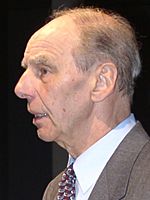Juris Hartmanis facts for kids
Quick facts for kids
Juris Hartmanis
|
|
|---|---|
 |
|
| Born | July 5, 1928 Riga, Latvia
|
| Died | July 29, 2022 (aged 94) |
| Alma mater |
|
| Awards | Turing Award (1993) |
| Scientific career | |
| Fields | Computer science |
| Institutions | |
| Doctoral advisor | Robert P. Dilworth |
| Doctoral students | Allan Borodin (1969), Dexter Kozen (1977), Neil Immerman (1980), Jin-Yi Cai (1986) |
Juris Hartmanis (July 5, 1928 – July 29, 2022) was a Latvian-born American computer scientist and computational theorist who, with Richard E. Stearns, received the 1993 ACM Turing Award "in recognition of their seminal paper which established the foundations for the field of computational complexity theory".
Life and career
Hartmanis was born in Latvia on July 5, 1928. He was a son of Mārtiņš Hartmanis, a general in the Latvian Army, and brother of the poet Astrid Ivask. After the Soviet Union occupied Latvia in 1940, Mārtiņš Hartmanis was arrested by the Soviets and died in a prison. Later in World War II, the wife and children of Mārtiņš Hartmanis left Latvia in 1944 as refugees, fearing for their safety if the Soviet Union took over Latvia again.
They first moved to Germany, where Juris Hartmanis received the equivalent of a master's degree in physics from the University of Marburg. He then moved to the United States, where in 1951 he received a master's degree in applied mathematics at the University of Kansas City (now known as the University of Missouri–Kansas City) and in 1955 a Ph.D. in mathematics from Caltech under the supervision of Robert P. Dilworth. The University of Missouri–Kansas City honored him with an Honorary Doctor of Humane Letters in May 1999. After teaching mathematics at Cornell University and Ohio State University, Hartmanis joined the General Electric Research Laboratory in 1958. While at General Electric, he developed many principles of computational complexity theory. In 1965, he became a professor at Cornell University. He was one of the founders and the first chair of its computer science department (which was one of the first computer science departments in the world).
Hartmanis contributed to national efforts to advance computer science and engineering (CS&E) in many ways. Most significantly, he chaired the National Research Council study that resulted in the 1992 publication Computing the Future – A Broad Agenda for Computer Science and Engineering, which made recommendations based on its priorities to sustain the core effort in CS&E, to broaden the field, and to improve undergrad education in CS&E. He was assistant director of the National Science Foundation (NSF) Directorate of Computer and Information Science and Engineering (CISE) from 1996 to 1998.
In 1989, Hartmanis was elected as a member into the National Academy of Engineering for fundamental contributions to computational complexity theory and to research and education in computing. He was a Fellow of the Association for Computing Machinery and of the American Mathematical Society, also a member of the National Academy of Sciences. He was also a foreign member of the Latvian Academy of Sciences, which bestowed him their Grand Medal in 2001 for his contributions to computer science.
Along with R.E. Stearns, Hartmanis received the 1993 Turing Award for a paper in which they introduced time complexity classes TIME(f(n)) and proved the time hierarchy theorem. Another paper by Hartmanis from 1977, with Leonard Berman, introduced the still-unsolved Berman–Hartmanis conjecture that all NP-complete languages are polynomial-time isomorphic.
Hartmanis died on July 29, 2022.
Awards
- Fellow, American Association for the Advancement of Science (AAAS), 1981
- Member, National Academy of Engineering, 1989
- Member (foreign): Latvian Academy of Sciences, 1990
- Member, American Academy of Arts and Sciences, 1992
- ACM Turing Award 1993
- Humboldt Foundation Research Award, 1993
- Charter Fellow, ACM, 1994
- Honorary Doctor of Humane Letters, 1999
- Computing Research Association (CRA) Distinguished Service Award, 2000
- Grand Medal of the Latvian Academy of Sciences, 2001
- ACM Distinguished Service Award, 2013
- Inaugural Fellow, American Mathematical Society, 2013
- Member, National Academy of Sciences, 2013
Selected publications
- Algebraic Structure Theory of Sequential Machines 1966 (with R.E. Stearns)
- Feasible Computations and Provable Complexity Properties 1978
- Computational Complexity Theory (ed.) 1989
- Computing the Future: A broader agenda for computer science and engineering (ed.) 1992 (with Herbert Lin)
- "Computational complexity of recursive sequences" 1964 (with R.E. Stearns)
- "Classifications of computations by time and memory requirements" 1965 (with P.M. Lewis and R.E. Stearns)
- "Hierarchies of memory limited computations" 1965 (with P.M. Lewis and R.E. Stearns)
- "On the computational complexity of algorithms" 1965 (with R.E. Stearns)
- Memory bounds for recognition of context-free and context-sensitive languages 1965 (with P.M. Lewis and R.E. Stearns)
- "On isomorphisms and density of NP and other complete sets" 1977 (with L. Berman)
- "Observations about the development of theoretical computer science" 1981
- "Gödel, von Neumann, and the P =? NP problem" 1989
Interviews
Juris Hartmanis has been interviewed four times. Videos are available for two of them. The most far-reaching one is by William Aspray.
- William Aspray interviews Hartmanis for the ACM Oral History interviews, 2009
- David Gries interviews Hartmanis for the Cornell ecommons collection, 2010
- Len Shustek interviews Hartmanis in an article in Communications of the ACM, 2015
- David Gries interviews Hartmanis as ACM Turing Award recipient, 2018
See also
 In Spanish: Juris Hartmanis para niños
In Spanish: Juris Hartmanis para niños

